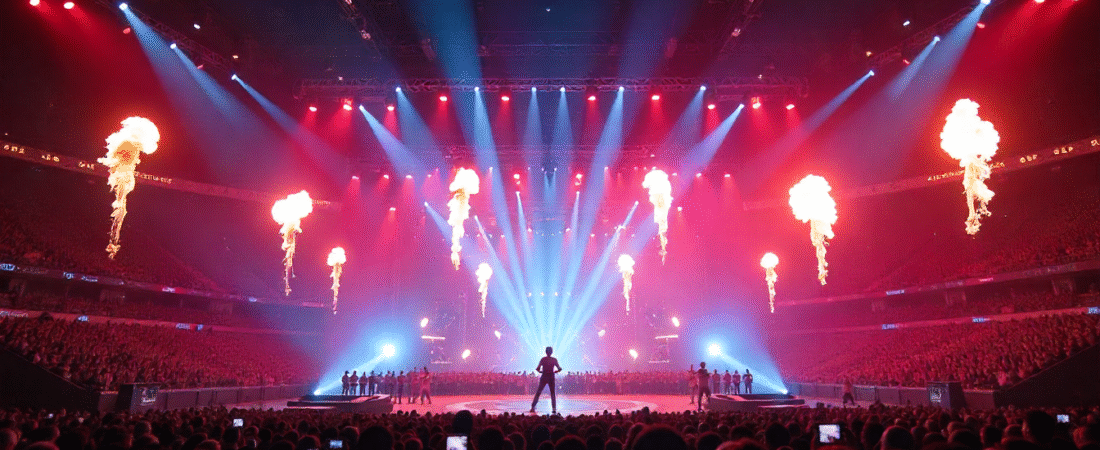“AI automated my job last year. This year, I’m automating AI.”
When a broadcast engineer told me this at NAB this year, I realized I’d been asking the wrong question.
I’d been wondering when AI would replace these roles.
He was already living in the world after that happened — and thriving.
His role hadn’t disappeared.
Instead, it had transformed into something unrecognizable from just five years ago.
What’s unfolding in broadcast engineering right now feels like a glimpse into the future of every technical-creative profession.
⸻
The Thing You Didn’t Notice
Think back to the 2025 Super Bowl halftime show — artists moving between physical and virtual stages, LED walls syncing live with broadcast feeds, millions of concurrent streams across platforms.
You saw a performance.
Engineers saw 127 different elements that could have gone catastrophically wrong.
Any one of them could have turned spectacle into chaos: a dropped frame in the virtual background renderer, a latency spike between the physical and LED stages, a color space mismatch that would’ve made skin tones look alien to 20 million mobile viewers.
But it didn’t.
Not because the technology was flawless — it never is.
Because someone made a judgment call that no algorithm could make: when one of the backup encoding paths showed stress at 78% capacity, the lead engineer didn’t wait for the automated failover. He switched manually, thirty seconds before the system would have.
The audience never knew.
The algorithm would have waited for the threshold.
A human read the pattern and acted on instinct.
That’s the evolution. We’re no longer keeping systems running. We’re conducting them.
⸻
From Infrastructure to Experience Design
The job description hasn’t caught up to what we actually do now.
Twenty years ago, broadcast engineering meant maintaining transmission systems, keeping signals clean, ensuring technical compliance. Success was measured in uptime and signal integrity.
Today? We’re designing emotional experiences across fragmented platforms.
A live event isn’t just a broadcast anymore — it’s twelve simultaneous experiences:
- 4K HDR for premium cable subscribers
- SDR fallback for standard cable
- Multiple bitrate streams for mobile apps
- Social media clips optimized for vertical viewing
- Archive masters for future remastering
- Accessibility feeds with enhanced audio description
Each needs different technical treatment. But they all need to feel like the same story.
That’s not a technical problem anymore. That’s a design problem with technical constraints.
And here’s what changed: AI can now handle most of the technical constraints.
Real-time color grading? Automated.
Audio level balancing? Automated.
Predictive system monitoring? Automated.
Format transcoding? Automated.
What AI can’t do — what it’s nowhere close to doing — is understanding when a frame needs to feel warmer, not just technically correct. When contrast should build tension versus when it should provide clarity. When a transition should be seamless versus when a deliberate cut serves the story better.
Those aren’t technical decisions. They’re emotional ones that happen to require technical implementation.
⸻
The New Skill: Knowing When to Override
Here’s what that engineer meant when he said he’s “automating AI.”
His facility uses AI for real-time exposure correction during live sports. It works beautifully 95% of the time. But during a recent broadcast, the AI kept “correcting” the dramatic underlighting of a pre-game ceremony — interpreting intentional mood as technical error.
He didn’t disable the AI. He trained it to recognize context: stadium brightness levels, time codes, audio cues that indicated ceremonial moments versus gameplay.
The AI got better. But it took human judgment to know what better meant in that context.
This is the new core skill: contextual override.
Knowing when to trust the automation.
Knowing when your instinct should overrule the algorithm.
Knowing when the data hasn’t captured something essential yet.
We’re not being replaced by AI. We’re becoming the editors of AI’s decisions.
⸻
What “Engineer” Doesn’t Capture Anymore
The traditional labels are failing us.
“Engineer” implies maintenance and technical execution.
“Producer” suggests content creation without infrastructure knowledge.
“Technical Director” sounds like you’re managing equipment, not designing experiences.
What’s emerging is something that doesn’t fit existing categories — someone who operates at the intersection of three domains:
Technology: Deep understanding of signal flow, encoding, networking, systems architecture.
Storytelling: Intuition about pacing, emotion, visual language, audience psychology.
Experience Design: Knowing how technical choices shape how a moment feels, not just how it looks.
Call it what you want — Media Architect, Experience Engineer, Broadcast Designer. The title matters less than recognizing this is fundamentally different from what the role was even five years ago.
When I talk to people entering the field now, I tell them: if you only know the technology, you’re learning skills AI will replicate. If you only understand storytelling, you won’t be able to implement it in increasingly complex technical environments.
The future belongs to people who can translate between those worlds — who can hear a creative direction like “make it feel more intimate” and know exactly which technical parameters to adjust, or know when the technical limitations actually serve the creative intent better than perfection would.
⸻
The Unforgiving Audience
Here’s what’s changed about audience expectations, and it’s counterintuitive:
Technical perfection matters less than it used to.
Emotional authenticity matters more.
Audiences will forgive mistakes.
They’ll overlook glitches.
But they won’t forgive indifference.
People will forgive a slightly soft focus, uneven lighting, even a brief glitch — if the content feels genuine, urgent, real.
What they won’t forgive is content that feels algorithmically optimized but emotionally hollow. Technically flawless but narratively flat.
There’s one major exception: live sports and news during critical moments.
When there’s a controversial play, a breaking news event, a moment where millions of people need to see the same thing clearly and immediately — that’s when technical execution becomes the entire story. The replay has to work. The angle has to be right. The latency has to be imperceptible.
But for everything else? Audiences have become more sophisticated about production while simultaneously more forgiving of imperfection.
They know what’s hard now. They know what’s authentic. They can sense when something is technically perfect but emotionally hollow.
This shift changes what we optimize for — not just “did it work,” but “did it land.”
That’s a human judgment that data can inform but not replace.
⸻
What This Means for How We Work
The workflow has inverted.
We used to build systems, then figure out what stories we could tell within their constraints.
Now we start with the experience we want to create, then architect systems that can deliver it — often in real time, often with tools that didn’t exist six months ago.
This requires a different kind of fluency — not just knowing how systems work, but being able to rapidly evaluate new tools, prototype workflows, and make irreversible decisions under pressure with incomplete information.
The engineers I know who are thriving right now share a few traits:
1. They’re aggressively curious about tools they don’t need yet.
They’re testing AI color grading tools even if they’re not implementing them. They’re experimenting with virtual production workflows even if their facility doesn’t have an LED volume. They’re staying six months ahead of what they’re currently being asked to do.
2. They speak both languages fluently.
They can sit in a creative meeting and understand what “more cinematic” actually means in executable terms. They can sit in a technical planning meeting and advocate for choices based on audience experience, not just system capability.
3. They treat every project as a prototype.
They’re not just executing a workflow — they’re evaluating it, documenting what worked, iterating for next time. They’re building institutional knowledge that survives technology changes.
4. They know what not to automate.
This might be the most important one. They’re not automating for the sake of efficiency. They’re selectively automating the repeatable so they have more bandwidth for the unprecedented.
⸻
The Question Nobody’s Asking
Everyone’s asking: “Will AI replace broadcast engineers?”
Nobody’s asking: “What will broadcast engineers become when they’re freed from the repetitive technical tasks that used to consume 70% of their time?”
That’s the more interesting question.
Because we’re already seeing the answer: we become designers of increasingly sophisticated experiences, conductors of complex systems, translators between creative vision and technical reality.
The craft isn’t disappearing. It’s concentrating into higher-order decision-making.
From signal integrity to emotional resonance.
From system maintenance to experience architecture.
From technical precision to perceptual nuance.
⸻
What Hasn’t Changed
For all the transformation, something fundamental remains:
The best broadcast engineers have always been the ones who understood that technology serves the story — not the other way around.
That hasn’t changed.
What’s changed is the complexity of the technology, the fragmentation of the platforms, and the speed at which we have to make decisions.
But the core instinct — knowing when the technical choice serves the emotional truth of the moment — that’s still human. Still essential. Still the difference between content that technically works and content that actually connects.
⸻
The Present Tense
If you’re reading this and wondering what your role becomes in an AI-augmented production environment, here’s what I’m seeing:
Your technical knowledge becomes the foundation, not the ceiling.
Your creative instinct becomes the differentiator.
Your ability to work in the space between technology and storytelling becomes your most valuable skill.
The role is more vital than ever — more human, more intuitive, more improvisational than before.
The engineers who thrive won’t be the ones who know the most about any single system.
They’ll be the ones who can move fluidly between technical execution and creative intuition — who can deploy AI when it serves the story and override it when human judgment matters more.
That’s not the future of broadcast engineering.
That’s its present tense.
And if you’re already living in it — you know exactly what I mean.

